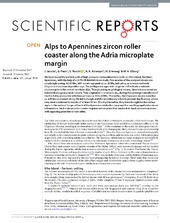Alps to Apennines zircon roller coaster along the Adria microplate margin
Jacobs, Joachim; Paoli, Gabriele; Rocchi, Sergio; Ksienzyk, Anna Katharina; Sirevaag, Hallgeir; Elburg, Marlina
Peer reviewed, Journal article
Published version

Åpne
Permanent lenke
https://hdl.handle.net/1956/22204Utgivelsesdato
2018-02-09Metadata
Vis full innførselSamlinger
- Department of Earth Science [1050]
Originalversjon
https://doi.org/10.1038/s41598-018-20979-wSammendrag
We have traced the particle path of high-pressure metasedimentary rocks on Elba Island, Northern Apennines, with the help of a U-Pb-Hf detrital zircon study. One quarter of the analysed zircons are surprisingly young, 41-30 Ma, with a main age peak at ca. 32 Ma, indicating an unexpected early Oligocene maximum deposition age. These Oligocene ages with negative εHf indicate a volcanic source region in the central-southern Alps. Though young by geological means, these zircons record an extraordinary geodynamic history. They originated in a volcanic arc, during the convergence/collision of the the Adria microplate with Europe from ca. 65 to 30 Ma. Thereafter, the Oligocene zircons travelled ca. 400 km southward along the Adria margin and the accretionary prism to present-day Tuscany, where they were subducted to depths of at least 40 km. Shortly thereafter, they were brought to the surface again in the wake of hinge roll back of the Apennine subduction zone and the resulting rapid extensional exhumation. Such a zircon roller coaster requires a microplate that has back-to-back subduction zones with opposing polarities on two sides.
